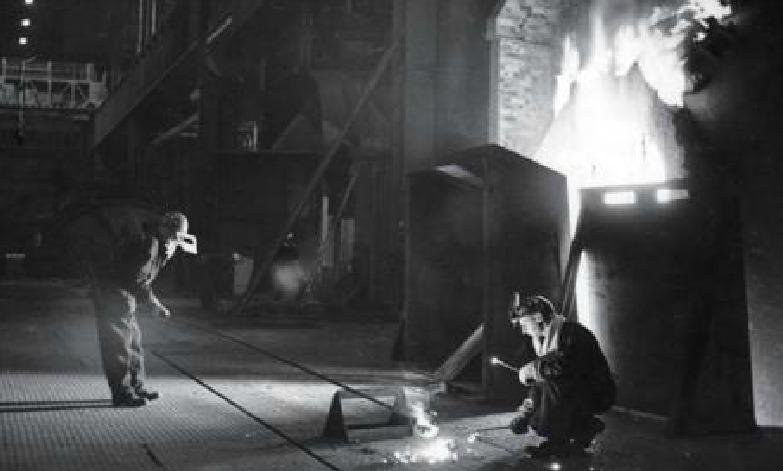A LASTING memorial to those who lost their lives working with molten metal in the steel-making industry is being unveiled today.
It coincides with the 40th anniversary of the closure of Consett Steelworks and will be attended by former workers and civic dignitaries.
The Consett Steelworkers Memorial stands on the former industrial site, which has now been redeveloped by modern companies and replaced with housing and business developments.
It is situated to the left of Tesco, near Starbucks, on Genesis Way, where blast furnaces once stood, and will be unveiled at 10.30am.
The memorial will be a permanent reminder of those who lost their lives in industrial accidents during almost 140 years of steelmaking in the town.

Consett Steelworks, which closed 40 years ago today
For decades heavy industry dominated the skyline and the area become famous for the thick red dust from iron oxide, which hung in the air.
This year also marks the 70th anniversary of a lethal carbon monoxide leak, which killed 11 men at the plant.
Thick clouds of poisonous carbon monoxide seeped from one of the furnaces, causing some to fall at their station, while others tried to crawl to safety.
It was July 1, 1950, prior to nationalisation, when the works was still known as Consett Iron Company.
Eleven men perished, 34 fell unconscious and, of those, 28 were treated at nearby Shotley Bridge Hospital.
Tom Gorman, whose father was among those hospitalised but survived the disaster, said workers entering the loading bay were overcome with the gas.
He said: “Eyewitnesses reported workers just dropping like they had been shot on the battlefield, something that would be familiar to many of course as it was only five years since the end of World War Two.
“Carbon monoxide is odourless and colourless so it would not be immediately apparent to others as to what was happening.
“Other workers just having started their shift rushed to aid their fellow workers and also quickly lost consciousness.
“It was only when works firemen wearing respirators arrived on the scene that the rescue operation began in earnest.”

Steelmaking was dangerous work
The book Consett Iron Company Deaths and Injuries 1850-1900 reports there were 50 separate deaths in this period, an average of one a year.
One of those deaths would be of an Irish migrant working in the town laying new railway lines.
He reportedly took a shortcut across the steelworks site after a night out drinking in Consett and fell into some molten slag.
Mr Gorman said he recalls his uncle fell from a cooling tower and was killed during the 1950s.
He added: “While the memorial is to the 11 men who lost their lives in the 1950 disaster, it should also be looked on as one for all those who died during the 140 year history of steelmaking in the town.
“I think that it is a fitting tribute to the men that lost their lives that a memorial is being unveiled.
“I think that everyone is familiar with local mining disasters and there are many memorials to these dotted across the county.
“It is about time that something was done to remember the steelworkers too.”
Hero steelworker who died in Consett blast furnace disaster
The men who died in the 1950 blast furnace disaster were: Arthur Briggs, 31, from Castleside; John Theldon Craggs, 54, Castleside; Francis Crawley, 30, Blackhill; Thomas Cook Easten, 25, Blackhill; Thomas Heslop, 32, Blackhill; Joseph Humble, 44, Consett; John Jeffrey, 46, Leadgate; Andrew Alan Kirby, 25, Blackhill; Richard Logan, 54, Villa Real; Arnold William Rose, 54, Leadgate; and Henry Tucker, 49, Consett.

The Company was a major employer in the town
North-West Durham MP Richard Holden said: “This memorial to the men who died at the steelworks is an important reminder of danger there was in working at The Company.
“Consett and the surrounding towns and villages have changed hugely since the works closed 40 years ago and I will continue to do everything I can to support investment into and the renewal of our area in the years ahead.”
Consett emerged as a town after the Derwent Iron Company was formed in 1841 following the discovery of iron ore deposits and the availability of coal for furnaces.
At the industry’s peak, in the 1960s, the works employed 6,000 people and the plant was nationalised as part of the British Steel Corporation.
The last steel was tapped at 12.28pm on Friday, September 12, 1980, by production scheduler Tommy Moore.
The industry had dominated Consett’s economy for 140 years and the loss of 3,700 jobs due to the closure had a devastating effect on the town.
It had a knock-on effect on the surrounding economy, sparking a range of health and social problems for communities in the area.
The loss of the steelworks marked the end of an era for the industrial north Durham town and the start of a new beginning.

Consett Steelworks during its heyday
Mike Clark, former chief executive of Derwentside District Council, now a director with Dysart Developments which works with Project Genesis redeveloping the steelworks site, said around £200m has been invested over the years.
He said: “The impact of closure and the legacy of the steelworks on health and life expectancy is important to remember but so is the positive work ethic and strength that permeates the community which is also the legacy of the steelworks and something that will continue to help the area develop in the future.”
Project Genesis, Derwent Valley Area Action Partnership and Durham County Councillors have funded the £35,000 memorial, which is being unveiled today.
Councillor Stephen Robinson said: “This memorial has took quite some time in coming and is long overdue, but I'm glad to see recognition of the men who lost their lives going to work for their families.”









Comments: Our rules
We want our comments to be a lively and valuable part of our community - a place where readers can debate and engage with the most important local issues. The ability to comment on our stories is a privilege, not a right, however, and that privilege may be withdrawn if it is abused or misused.
Please report any comments that break our rules.
Read the rules here